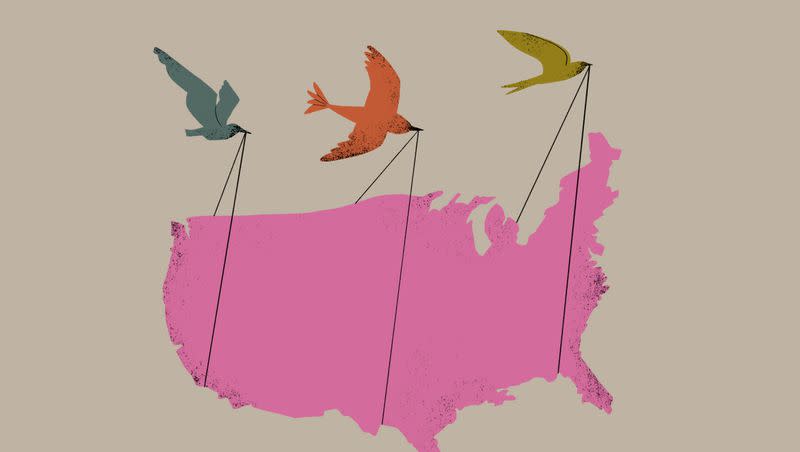Perspective: The dream of a religiously diverse democracy is ours to achieve

Imagine for a moment that all of the institutions founded by faith communities vanished from your city.
In Chicago, where I live, here is what would be gone: Loyola and DePaul universities, Wheaton College, Northwestern and Rush Hospital, plus the Catholic K-12 schools that educate nearly 100,000 students in the Chicagoland area. Not just the worship spaces of Fourth Presbyterian Church, Temple Sinai and the Downtown Islamic Center, but their tutoring programs, soup kitchens, conference spaces and Thanksgiving turkey drives.
On a national scale, the disappearance of institutions founded by faith communities would render our civic landscape literally unrecognizable. Consider, for example, the disaster relief agencies founded by The Church of Jesus Christ of Latter-day Saints and by Southern Baptists, which help countless people recover after earthquakes, tornadoes and hurricanes.
Or think about the 230 Catholic colleges and universities in the country, the 120 institutions of higher education founded by Methodists, or the nearly 150 run by evangelical Christians. The vast majority of these schools educate students who are not of their community.
The great constitutional promise of America is freedom of religion. The great genius of America follows from that promise: if you give people the freedom to express their faith, they will use that freedom to build up their nation. They will take the inspiration of their faith, plant it in American soil, and grow out of it institutions that serve people of all faiths and philosophies, from atheist to Zoroastrian.
We are so accustomed to this that we take it for granted. But the truth is that this freedom of religious expression is a rare achievement in human history. I realized this when I read a New York Times article about the civic landscape of the city of Mostar, in the nation of Bosnia-Herzegovina. It opened with a revealing illustration of the city’s religious divide: when there is a fire on the Muslim side of Mostar, the Catholic fire department does not respond. Conversely, when there is a fire on the Catholic side, the Muslim fire department does not respond.
The article by Andrew Higgins goes on to describe an entire city organized along such lines. Muslims and Catholics go to separate nightclubs, cheer for separate sports teams, give their garbage to different waste-collection companies, and attend school in the same building — but at different times of the day.
This is not the exception; this is the norm. For most of human history, identity communities built institutions to benefit their own groups, and these institutions often cultivated hostility with other communities.
Related
Perspective: When it comes to nurturing pluralism, the secret is serving others
Democracy as a sacred endeavor — a conversation with Adam Russell Taylor
This is why political philosophers for centuries believed that diverse democracies were simply not possible. If you wanted ethnic, racial and especially religious diversity, you better have a dictator to keep things in line.
You know who didn’t believe those political philosophers? The Founding Founders of the 1776 generation. These were men who, as David French points out in his wonderful book “Divided We Fall,” were descendants of combatants in the European wars of religion. And yet they came to these shores and believed they could build something truly new in human history: a nation where people arriving from the four corners of the Earth, praying to God in different ways (some, not at all), could come to a single patch of land and build out of it a nation.
Thomas Jefferson owned a Qur’an. Ben Franklin made donations to every faith community in Philadelphia, encouraging them to follow their faith and to come together to celebrate America’s Independence Day.
George Washington received a letter from a Jewish leader named Moses Seixus, asking what would happen to the Jewish people, a faith community that had been hounded and hated and harassed for a millennium in Europe, in the new nation.
Washington wrote back in a beautiful early document called the Letter to the Hebrew Congregation of Newport, Rhode Island: “My government will give to bigotry no sanction and to persecution no assistance. Let the children of the stock of Abraham sit in safety under their own vine and fig and let there be none to make them afraid.”
When it comes to interfaith cooperation, the Founders set a standard that we the American people have for generations been striving to achieve. Abraham Lincoln did his part when he spoke out about the anti-Catholicism of the Know-Nothing Party in the middle of the 19th century.
Jane Addams did her part when she built Hull House, which she called a “cathedral of humanity,” and deliberately shaped it as a space where Protestants, Catholics and Jews could share the inspiration of their faith and engage in what she called “the fellowship of the deed.”
The Rev. Martin Luther King Jr and Rabbi Abraham Joshua Heschel did their part when they build a Baptist-Jewish friendship, marched together for civil rights in Selma, Alabama, and noted that even though their liturgy was different, walking in Selma for freedom, it was as if their legs were in prayer.
To paraphrase T.S. Eliot: We do not simply inherit traditions. We work to make ourselves worthy of them. Our generation cannot just be grateful for the north star lodged by the founders, and the work that others have done to reach it. We must move the nation closer to that ideal ourselves.
Eboo Patel, the founder and president of Interfaith America, is a contributing writer for the Deseret News, the author of “We Need to Build: Field Notes for a Diverse Democracy” and the host of the podcast “Interfaith America with Eboo Patel.”

